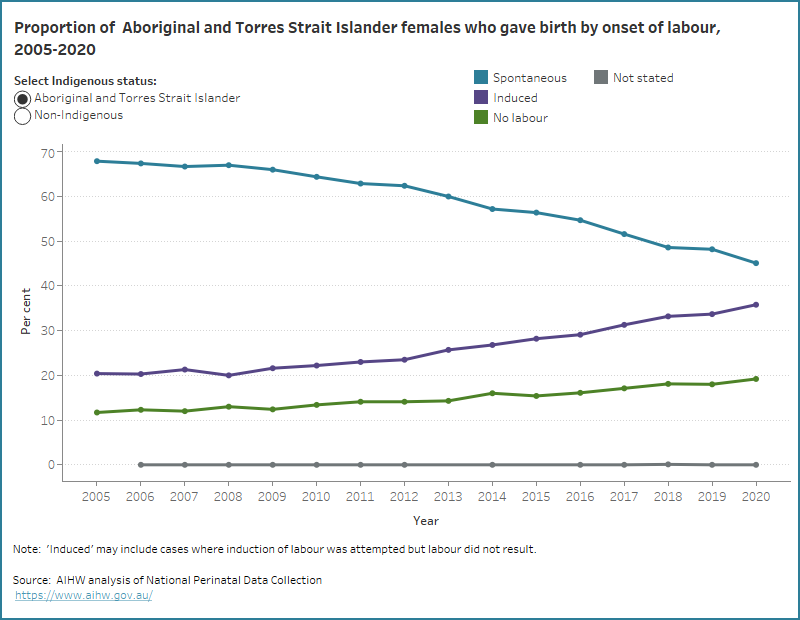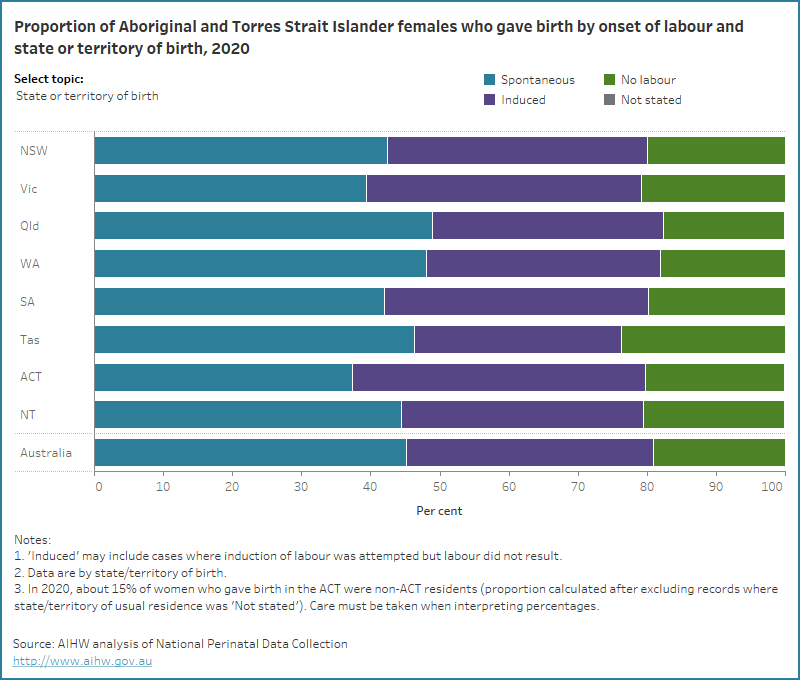 Onset of labour
Onset of labour
Labour can occur spontaneously or may be induced by medical or surgical intervention. If there is no labour, a caesarean section is performed.
Induction of labour is performed for a number of reasons, and most inductions are performed for indications related to maternal or baby medical conditions or obstetric complications (Coates et al 2020; AIHW 2022). Whilst most women who have induced labour – and their babies – do well, induction of labour does increase the risk of infection and bleeding, and a less positive birth experience when compared to spontaneous labour (Coates et al 2020; Grivell et al 2012).
In 2020, 45% of Aboriginal and Torres Strait Islander females who gave birth had spontaneous labour, 36% had induced labour and 19% had no labour (compared with 41%, 36% and 24%, respectively, for non-Indigenous females).
Over time, the proportion of Aboriginal and Torres Strait Islander mothers who had spontaneous labour has decreased (from 68% in 2005 to 45% in 2020), with a corresponding increase in the proportion who had induced labour from a low of 20% in 2008 to 36% in 2020.
The data visualisation below shows the proportion of Aboriginal and Torres Strait Islander and non-Indigenous females who gave birth by onset of labour, from 2005.
Figure 1: Proportion of Aboriginal and Torres Strait Islander and non-Indigenous females who gave birth by onset of labour from 2005 to 2020
Line graph of onset of labour and Indigenous status. Aboriginal and Torres Strait Islander mothers with induced labour increased.

In 2020, the Aboriginal and Torres Strait Islander females who gave birth and were more likely to have spontaneous labour were those who:
- lived in the most disadvantaged areas (46%, compared with 43% of those from the fourth area of disadvantage (quintile 4))
- lived in Outer regional areas (48%, compared with 44% from Major cities)
- were aged under 20 years (53%, compared with 26% of those aged 40 years and over)
- had a parity of 1 (47%, compared with 42% of those with a parity of 4 or more)
- had a non-instrumental vaginal birth (59%, compared with 49% of those who had and instrumental vaginal birth).
The data visualisation below presents data on onset of labour for Aboriginal and Torres Strait Islander females who gave birth, by selected maternal characteristics for 2020.
Figure 2: Proportion of Aboriginal and Torres Strait Islander females who gave birth by onset of labour and selected topic for 2020
Bar chart for the onset of labour by selected topics. 45% of Aboriginal and Torres Strait Islander mothers had spontaneous labour.

Aboriginal and Torres Strait Islander mothers who lived in some geographical locations were more likely to have induced labour. Explore the map below to view data on the number and proportion of Aboriginal and Torres Strait Islander mothers who had induced labour, by IREG and PHN for 2020 and SA3 for 2017-2020.
Figure 3: Proportion of Aboriginal and Torres Strait Islander females who gave birth and had induced labour by various geographies
Map of proportions of Aboriginal and Torres Strait Islander mothers who had induced labour across Australia grouped by various geographies.
References
AIHW (Australian Institute of Health and Welfare) (2022) Australia’s mothers and babies, Cat. no. PER 101. Canberra: AIHW.
Coates D, Makris A, Catling C, Henry A, Scarf V, Watts N, Fox D, Thirukumar P, Wong V, Russell H and Homer C (2020) ‘A systematic scoping review of clinical indications for induction of labour’, PLOS One, 15(1): e0228196, doi:10.1371/journal.pone.0228196.
Grivell RM, Reilly AJ, Oakey H, Chan A and Dodd JM (2012) ‘Maternal and neonatal outcomes following induction of labor: a cohort study’, ACTA Obstetricia et Gynecologica Scandinavica, 91(2):198–203, doi:10.1111/j.1600-0412.2011.01298.x.


